The best thermal binoculars combine exceptional thermal resolution, long detection ranges, and user-friendly features like laser rangefinders, video recording, and multiple color palettes, ensuring superior performance across various applications. Whether you’re tracking elusive game or enhancing your nighttime security, investing in the right thermal binoculars can elevate your capabilities to new heights.
Thermal binoculars have revolutionized the way we perceive the world in challenging environments, offering unparalleled visibility in total darkness, dense fog, or heavy foliage.
Unlike traditional optics, these devices rely on advanced infrared technology to detect heat signatures, making them indispensable tools for hunters, wildlife enthusiasts, law enforcement, and search-and-rescue teams.
Best Thermal Binoculars
1) Pulsar Merger LRF XL50 2.5-20x Thermal Binocular
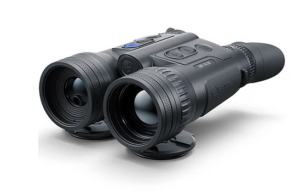
The Pulsar Merger LRF XL50 is the best thermal Binocular. It features a 2,500-yard detection range,1024×768 pixels resolution, 50 Hz refresh rate, built-in photo and video recorder,high-contrast HD AMOLED display, 8 color palettes, magnesium alloy housing, and operation in extreme temperatures -25 to +50°C.
This binocular is designed for hunters, law enforcement, and outdoor enthusiasts, the XL50 combines cutting-edge technology with a rugged yet ergonomic build to deliver unparalleled performance in thermal imaging.
At the core of the Merger LRF XL50 is its 1024 x 768, 12μm thermal imaging sensor, paired with a fast-aperture F50/1.0 germanium lens. This powerful combination allows for crystal-clear detection and identification of objects up to 2,500 yards, even in extreme weather conditions. The dual HD AMOLED displays provide high contrast, vivid colors, and a smooth viewing experience, making every detail count in low-light or complete darkness.
For enhanced adaptability, the device offers three levels of sensitivity amplification and eight color palettes, allowing users to tailor their thermal view to specific scenarios. Whether detecting subtle temperature changes or identifying targets in cluttered environments, the Merger LRF XL50 ensures precision and reliability.
Understanding target distances is crucial in making informed decisions, and the integrated laser rangefinder with a range of up to 1,000 yards provides this capability with exceptional accuracy. Users can choose between single measurement or continuous scanning modes, both offering an impressive ±1-meter precision. This feature ensures quick, error-free assessments for hunters and professionals alike.
The Merger LRF XL50 comes equipped with built-in video and photo recording capabilities, boasting 16 GB of internal storage. Paired with Stream Vision 2 app compatibility via dual Wi-Fi waveband support (2.4/5 GHz), users can easily transfer media, update firmware, and even stream live footage directly to their smartphones. Whether capturing your adventures or sharing critical information, the connectivity features elevate the usability of the XL50.
Constructed with a magnesium alloy housing, the Merger LRF XL50 is IPX7 waterproof-rated, capable of withstanding submersion in up to one meter of water for 30 minutes. With an operational temperature range of -13°F to 122°F, the binoculars are ready for action in virtually any environment.
The ergonomic, classic binocular design ensures comfortable use for extended periods, while the proximity sensor enables covert operations by automatically turning off displays when not in use.
Pros
- High-resolution thermal imaging: 1024 x 768 sensor with long-range detection up to 2,500 yards.
- Precision laser rangefinder: Accurate measurements up to 1,000 yards.
- Advanced recording and connectivity: Built-in recorder, 16 GB storage, and Stream Vision 2 app support.
- Durable and weather-resistant: IPX7 waterproof rating and magnesium alloy build.
- Customizable viewing: Eight color palettes and sensitivity amplification levels.
- Dual HD AMOLED displays: Crisp, vibrant visuals for both eyes.
Cons
- Premium price point: Advanced features come with a higher cost.
2) Pulsar Merger LRF XQ35 3-12x35mm Thermal Binocular
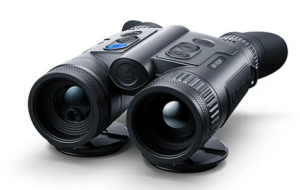
The Pulsar Merger LRF XQ35 3-12x35mm Thermal Binocular combines cutting-edge thermal imaging with a compact and ergonomic design, making it one of the best thermal binoculars for hunters, outdoor enthusiasts, and professionals requiring reliable performance in all weather conditions. With a highly sensitive European-made thermal sensor and advanced features, the Merger LRF XQ35 redefines excellence in thermal imaging technology.
Equipped with a 384×288 pixel thermal sensor and a <25mK NETD (Noise Equivalent Temperature Difference), the Merger LRF XQ35 provides remarkable clarity and detail even under challenging conditions like fog, rain, or high humidity. This advanced sensor ensures that even the smallest temperature differences are visible, giving users a decisive advantage when detecting and identifying targets.
The fast-aperture F35/1.0 germanium lens enhances the binocular’s ability to capture fine details, delivering high-contrast and sharp imagery for precise observations.
The Merger LRF XQ35 features a built-in proximity sensor that automatically turns the displays on or off based on proximity to the user’s face. This prevents backlight exposure, ensuring complete discretion during nighttime operations. Additionally, the user-mode memory function allows you to save customized brightness and contrast settings, ensuring optimal image quality with no need for repeated adjustments.
Understanding the distance to your target is critical for successful decision-making, and the Merger LRF XQ35 excels with its integrated laser rangefinder. Capable of measuring distances beyond 1,000 yards with ±1-meter accuracy, the rangefinder supports both single measurements and continuous scanning modes, providing quick and reliable distance assessments.
Constructed with a magnesium alloy housing, the Merger LRF XQ35 is both lightweight and durable, able to withstand shocks, drops, and extreme temperatures. The housing not only protects internal components but also dissipates heat for consistent performance during extended use. With an IPX7 waterproof rating, the binoculars remain operational even in heavy rain or submersion in up to 1 meter of water for 30 minutes.
The Merger LRF XQ35 employs a dual-battery system comprising one built-in 4Ah battery and one replaceable 3.2Ah battery. Together, they provide up to 11 hours of continuous operation, and the replaceable battery’s tactile embossment ensures quick and confident swaps in complete darkness.
Pros
- Exceptional image quality with advanced thermal sensor and lens.
- Laser rangefinder for accurate and quick distance measurement.
- Customizable settings with user-mode memory for convenience.
- Rugged build ensures reliability in harsh environments.
- Long battery life with dual power system.
- Compact and ergonomic for comfortable handling.
Cons
- Replaceable battery design might require spare purchases for extended trips.
3) ATN Binox 4T 640 2.5-25×50 Thermal Binocular
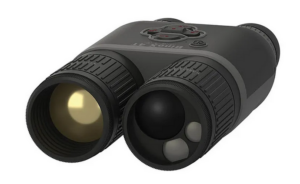
The ATN Binox 4T 640 2.5-25×50 Thermal Binocular is a state-of-the-art thermal imaging device designed for hunters, outdoor enthusiasts, and professionals who demand top-tier performance. With advanced technology like Ballistic Information Exchange (BIX), integrated laser rangefinding, and video recording capabilities, this binocular is one of the best thermal binoculars.
At the heart of the ATN Binox 4T 640 is an ultra-sensitive 640×480 thermal sensor, which provides exceptional clarity and detail in any lighting condition. With black hot, white hot, and color viewing modes, users can customize their viewing experience to suit specific environments.
The variable magnification from 2.5x to 25x ensures sharp, detailed imagery for both close-range and long-distance observations, while the smooth zoom function offers precise control for tracking and identifying targets.
One of the standout features of the Binox 4T 640 is its Ballistic Information Exchange (BIX) technology. This allows seamless pairing with ATN SMART HD devices, such as ATN SMART Rifle Scopes, to instantly transmit range and ballistic data.
The paired scope can automatically adjust its settings, giving hunters a significant edge in the field. For those without ATN devices, the binocular works with the Laser Ballistics app, allowing users to calculate adjustments manually.
The binocular’s built-in laser rangefinder is effective up to 1,000 yards and functions flawlessly during the day or night. Additionally, the built-in IR illuminator enhances compatibility with night vision devices, providing tactical versatility in low-light conditions.
The ATN Binox 4T 640 is packed with user-friendly features like dual Wi-Fi streaming and the ability to record Full HD videos to an internal SD card. This makes it easy to document and share your hunting adventures in stunning clarity.
With a 16+ hour runtime on its internal lithium battery, this binocular is built to last through extended expeditions. Its weather-resistant design ensures reliable performance in challenging outdoor environments.
Designed with comfort and durability in mind, the Binox 4T 640 features a 60-70mm interpupillary adjustment range and 10-30mm eye relief for a customizable and comfortable viewing experience. Weighing just 2.5 lbs, it is lightweight enough for long treks but robust enough to handle tough conditions.
Pros
- Exceptional image quality with an ultra-sensitive thermal sensor.
- Advanced rangefinding for accurate distance measurements day or night.
- BIX technology for seamless integration with ATN SMART scopes.
- Video recording and streaming capabilities for sharing and documentation.
- Long battery life ensures uninterrupted use during extended outings.
- Compact and ergonomic design with adjustable interpupillary distance.
Cons
- Weather-resistant rather than fully waterproof.
- A Steeper learning curve for users unfamiliar with advanced features like BIX.
4) AGM Global Vision Voyage LRF FB75-640 Fusion Thermal Binocular
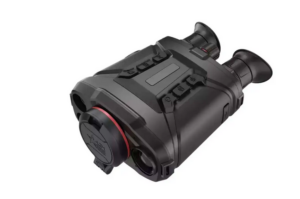
The AGM Global Vision Voyage LRF FB75-640 Fusion Thermal Binocular represents the pinnacle of modern thermal imaging technology, blending precision optics, cutting-edge thermal performance, and advanced functionality. This dual-spectrum thermal binocular is engineered to meet the demands of hunters, outdoor enthusiasts, and professionals who require reliable and versatile imaging tools in the most challenging environments.
One of the standout features of the AGM Voyage LRF FB75-640 is its dual-spectrum image fusion, which enhances detail recognition and target identification. Users can switch between the thermal view channel, visible light channel, or combine both for unparalleled situational awareness. The 640×512 thermal resolution and 2560×1440 optical resolution deliver unmatched image clarity, ensuring no detail is overlooked.
The binocular features Digital Detail Enhancement (DDE) and Dynamic Noise Reduction (3D DNR), which further refine image quality by improving contrast and reducing interference, even in adverse conditions. Additionally, the Adaptive Automatic Gain Control (AGC) adjusts imaging parameters in real time, allowing for seamless performance in varying lighting scenarios.
The integrated eye-safe laser rangefinder provides precise distance measurements up to 1,000 meters, with an accuracy of ±1 meter. Combined with features like the digital magnetic compass, GPS module, and inclination sensor, the AGM Voyage offers an impressive suite of tools for navigation, target tracking, and situational awareness.
Users can record videos, take snapshots, and replay events directly on the device, ensuring critical moments are captured and easily reviewed. The binocular also includes a Wi-Fi hotspot, enabling effortless sharing and remote control capabilities. Its proximity sensor conserves power by detecting when the device is not in use, extending the up to 8-hour battery life for prolonged missions.
With an IP67 waterproof rating, the AGM Voyage LRF FB75-640 is designed to withstand harsh outdoor conditions. Its robust build ensures durability, while the ultra-low illumination capabilities allow it to perform exceptionally well in near-complete darkness. Backed by a 5-year limited warranty, this binocular is built to provide years of reliable service.
Pros
- Exceptional image clarity through dual-spectrum fusion and high resolutions.
- Advanced image processing with DDE, 3D DNR, and AGC for optimal performance.
- Accurate and reliable rangefinding with a laser rangefinder.
- Comprehensive navigation tools, including GPS and magnetic compass.
- Multimedia functionality for recording and reviewing events.
- Durable and waterproof with an IP67 rating for harsh environments.
- Power-saving design with proximity sensor for extended battery life.
Cons
- Shorter battery life compared to some competitors with 16+ hours.
5) Guide Sensmart TN series LRF TN650 2.8-22.4x50mm Thermal Binocular
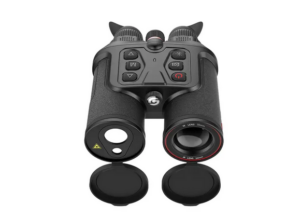
The Guide Sensmart TN Series LRF TN650 2.8-22.4x50mm Thermal Binocularsets a high standard for thermal imaging, offering powerful performance in a compact and durable package. Designed for hunters, security professionals, and outdoor enthusiasts, this binocular delivers exceptional image quality, long-range detection, and advanced functionality, making it one of the best thermal binoculars available.
Equipped with a 640×480 VOx uncooled IR sensor and a 50Hz frame rate, the TN650 provides smooth and detailed imaging even when tracking fast-moving targets. The thermal sensor, with a sensitivity of ≤30mk, ensures excellent performance in a variety of environmental conditions, capturing fine details in both day and night scenarios. With multiple color palettes such as Black Hot, White Hot, and Iron Hot, users can customize their viewing experience to suit specific tasks.
The TN650 boasts an impressive detection range of up to 2800 yards and an integrated laser rangefinder capable of measuring distances up to 1500 meters (1630 yards) with precision. This rangefinder offers both single and continuous ranging modes, enabling accurate target acquisition at extreme distances. The manual focus and digital zoom options (1x, 2x, 4x, and 8x) provide flexibility for observing and identifying targets in detail.
Designed for comfort during extended use, the binocular features an adjustable interpupillary distance (60-70mm) and raised buttons that are easy to identify, even in low-light or total darkness. Weighing only 31 ounces, the TN650 is compact and easy to handle. The IP66 waterproof rating ensures reliable performance in harsh weather conditions, with an operational temperature range from -22°F to 122°F, making it suitable for all environments.
The TN650 offers seamless connectivity with Wi-Fi streaming, enabling users to share images and videos in real time. Its display resolution of 1024×768 delivers a clear and vivid viewing experience. Despite its advanced capabilities, the 5.5-hour battery life ensures you can tackle demanding tasks without interruption.
Pros
- Outstanding image clarity with a high-resolution sensor and 50Hz frame rate.
- Exceptional detection range of 2800 yards and precise laser rangefinder functionality.
- Customizable viewing options with multiple color palettes and zoom levels.
- Ergonomic design minimizes fatigue during extended use.
- Weather-resistant and durable, with IP66 waterproofing and a wide operating temperature range.
- Wi-Fi streaming for real-time sharing and recording.
Cons
- Limited battery life compared to some competitors at 5.5 hours.
- Manual focus may require more adjustment time in dynamic situations.
Next Read
Which is better, night vision or thermal binoculars?
The choice between night vision and thermal binoculars depends on the intended use.
Night vision binoculars amplify existing light to provide detailed images in low-light conditions, making them ideal for scenarios where identifying facial features or reading signs is crucial. However, they require some ambient light and are less effective in total darkness or obscured environments.
Thermal binoculars, on the other hand, detect heat signatures, allowing users to see in complete darkness, through fog, smoke, or foliage. This makes them better for detecting wildlife, tracking movement, or locating heat-emitting objects. For general outdoor activities or hunting, thermal binoculars often provide greater versatility, while night vision excels in light-dependent, detail-oriented tasks.
What is the range of thermal binoculars?
What is the difference between thermal binoculars and night vision binoculars?
Factors to Consider when Choosing the Best Thermal Binoculars
Thermal Resolution
Thermal resolution determines the clarity and detail of the thermal image. Higher resolution sensors, such as 640×480 pixels or above, provide sharper images, making it easier to distinguish objects, especially at longer distances or in complex environments.
Lower-resolution sensors, while more affordable, may struggle to provide sufficient detail for precise target identification. Opting for higher thermal resolution ensures you can detect subtle temperature differences, which is crucial for activities like hunting or search-and-rescue.
Detection Range
The detection range is a key factor that defines how far the binoculars can detect heat signatures. Binoculars with longer detection ranges, typically exceeding 1,000 yards, are ideal for long-distance observations in open terrains.
For closer-range use, such as wildlife spotting in dense forests, shorter detection ranges may suffice. Understanding your intended application ensures you select a model that meets your distance requirements without unnecessary expense.
Frame Rate and Image Refresh
The frame rate, typically measured in Hertz (Hz), impacts how smoothly the image is displayed during motion. A higher frame rate, such as 50 Hz, ensures a fluid viewing experience, particularly when tracking fast-moving targets.
Lower frame rates can result in choppy visuals, reducing the effectiveness of the binoculars in dynamic scenarios. Prioritize a higher frame rate if you anticipate observing moving objects or operating in environments where speed is critical.
Field of View (FOV)
The field of view is the width of the area visible through the binoculars at a given distance. A wider FOV is advantageous for scanning large areas or tracking moving targets, while a narrower FOV provides more magnified, focused views. Consider your use case: for search-and-rescue or wildlife observation, a wider FOV may be preferable, while long-distance hunting might benefit from a narrower, more detailed view.
Battery Life
Battery life is a crucial consideration, especially for extended outdoor activities. Thermal binoculars with long-lasting batteries, typically offering over five hours of continuous operation, ensure uninterrupted use. Models with replaceable or rechargeable batteries provide added flexibility. Evaluate the battery capacity and charging options to match your needs, particularly if you’ll be in remote areas without easy access to power sources.
Durability and Weather Resistance
Durability is essential for thermal binoculars, which are often used in rugged outdoor conditions. Look for devices with robust construction, such as magnesium alloy or reinforced housings, to withstand shocks and drops.
Weather resistance, rated by standards like IP66 or IP67, ensures the binoculars can endure rain, humidity, dust, and extreme temperatures. This feature is particularly important for those using the device in challenging or unpredictable environments.
Ease of Use and Ergonomics
Thermal binoculars should be comfortable to hold and easy to operate, even during prolonged use. Adjustable interpupillary distance, ergonomic grips, and well-placed, tactile buttons enhance usability.
Features like proximity sensors, intuitive menus, and customizable settings contribute to a seamless user experience. These considerations are especially important for those who require quick adjustments or plan to use the device in low-light or high-pressure scenarios.
Additional Features
Modern thermal binoculars often come with advanced features like integrated laser rangefinders, video recording, Wi-Fi streaming, and multiple color palettes. These enhancements can greatly improve functionality, offering benefits like precise distance measurement, the ability to record observations, or sharing visuals in real-time.
Prioritize features that align with your intended use while avoiding unnecessary complexities that might overcomplicate the device or increase its cost.
